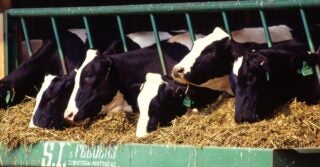- Resources
- To Meet Sustainability Goals, Food Companies Need To Slash Methane
Resources
To Meet Sustainability Goals, Food Companies Need To Slash Methane
Published: June 24, 2021 by Katie Anderson
As the recent surge in corporate net zero commitments suggests, the risks associated with climate change are top of mind for today’s leading businesses and investors.

For companies that produce, process or sell beef, pork and/or dairy, there’s an often overlooked, invisible source of climate pollution lurking in the supply chain: methane.
An extremely potent greenhouse gas, methane has more than 80 times the warming power of carbon dioxide in the short term. This means cutting methane emissions is one of the fastest ways for businesses to make progress toward their sustainability targets, meet growing stakeholder demands for bold climate action and be more resilient.
The opportunity for leadership is especially urgent in the livestock sector, which is responsible for roughly one-third of all human-caused methane emissions globally.
While some food and agricultural companies are making progress on methane, there’s still a long way to go. Here’s what these companies need to know.
Managing methane is good for business
Food and agricultural companies are especially vulnerable to climate change risks, given increases in extreme and volatile weather, which can impact their productivity as well as their long-term resilience.
Methane is indirectly affecting agricultural productivity through climate change and ozone pollution, which is known to harm ecosystems and plants.
Fortunately, fast and ambitious methane mitigation can help avoid crop losses caused by ozone pollution. For example, a recent report indicates that productivity of key commodities increases by 145,000 tons for every 1 million tons of methane reduced.
Livestock pollution disproportionally impacts communities
In addition to its potent effect on climate, livestock production also has localized impacts — on water quality, pollution and odor, for example — that often disproportionally affect low wealth communities and communities of color because of the location of livestock farms.
Addressing these localized impacts is a business imperative. So, too, is engaging affected local communities, to choose the most appropriate solutions. These solutions include technologies to mitigate the impact of livestock pollution at the local level, which should be used when and where they align with community needs.
Immediate methane reduction is crucial
While the warming impact of methane is concentrated during its first decade or so in the atmosphere, most companies use the warming potential of GHGs over 100 years to compare impacts between different greenhouse gases, called CO2-equivalents (CO2e).
When you look at methane over a 100-year period vs. a 20-year period, however, its warming potential drops from 84 times more potent than CO2 to just 28. This discounts the critical role that methane plays in the rate of warming today.
This also gives livestock companies a timely opportunity. They can make faster progress against their corporate climate goals — including net zero — by prioritizing early action on methane.
That means supporting global methane emission reduction targets in line with what the science recommends, investing in innovation and advocating for policies that help livestock farmers reduce methane and other pollution.
